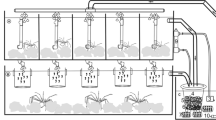Abstract
Since 1987, when the red drum, Sciaenops ocellatus, was introduced into Taiwan, research has been concentrated on its feasibility and biological studies applied to aquaculture. As a part of these biological studies, an experiment was conducted to investigate the timing and factors affecting cannibalism in red drum larvae in captivity. Experimental larvae were graded into small and large sizes. Four treatments were then applied: (1) the control group, (2) water turbidity increased by adding green algae, (3) density of larvae increased twofold, and (4) satiation feeding with Artemia nauplii. Each treatment was triplicated, each in a 12 l test tank stocked with 20 large and 20 small test larvae except those with doubled density of larvae. In a period of three days, the size difference in test larvae was found to be the most important factor affecting cannibalism, whereas water turbidity and density of larvae showed no apparent effect. Satiation feeding significantly decreased but did not stop cannibalism. The peak stage of cannibalism for red drum larvae was likely to occur at a total body length of 1.8–1.9 cm, when the ratio of lower jaw length to total body length was at its maximum.
Similar content being viewed by others
References cited
Brabrand, A. 1995. Intra-cohort cannibalism among larval stages of perch (Perca fluviatilis). Ecol. Freshwater Fish 4: 70–76.
Dowd, C.E.&M.E. Clarke. 1989. An experimental investigation of cannibalism in hatchery-reared juvenile redfish (Sciaenops ocellatus) and snook (Centropomus undecimalis). p. 486. In: Rapports et Proces-Verbaux des Reunions Conseil International Pour L'Exploration de la Mer. vol. 191 (available as: The early life history of fish, The Third ICES Symposium, Bergen, 3–5 Oct 1988).
Folkvord, A. 1991. Growth, survival and cannibalism of cod juveniles (Gadus morhua): effects of feed type, starvation and fish size. Aquaculture 97: 41–59.
Folkvord, A.&H. Ottera. 1993. Effects of initial size distribution, day length, and feeding frequency on growth, survival, and cannibalism in juvenile Atlantic cod (Gadus morhua L.). Aquaculture 114: 243–260.
Fortier, L.&A. Villeneuve. 1996. Cannibalism and predation on fish larvae by larvae of Atlantic mackerel, Scomber scombrus: trophodynamics and potential impact on recruitment. U.S. Fish. Bull. 94: 268–281.
Gres, P.&A. Belaud. 1995. Reduction of early cannibalism of young pike (Esox lucius) in intensive rearing. Ichtyophysiologica Acta 18: 23–41.
Hecht, T.&A.G. Pienaar. 1991. Cannibalism: the hidden mortality factor in larviculture. p. 277. In: P. Lavens, P. Sorgeloos, E. Jaspers& F. Ollevier (ed.) LARVI' 91 – Fish&Crustacean Larviculture Symposium, European Aquaculture Society, Special Publication No. 15, Gent.
Hecht, T.&A.G. Pienaar. 1993. A review of cannibalism and its implications in fish larviculture. J. World Aquac. Soc. 24: 246–261.
Li, C., H. Bo& E. You. 1992. Relationship between the water turbidity and the phenomenon of cannibalism of the juvenile of black sea bream, Sparus macrocephalus. Marine fisheries/Haiyang Yuye, Shanghai 14: 58–59 (in Chinese).
Liao, I.C. 1994. The biology of red drum, Sciaenopes ocellatus. I. Relationships between total length, standard length, and body weight of 10 to 2500 g fish. J. Fish. Soc. Taiwan 21: 79–89 (in Chinese).
Liao, I.C., M.S. Su& L.S. Hsieh. 1994. Spontaneous spawning of red drum (Sciaenops ocellatus) in Taiwan. pp. 211–214. In: L.M. Chou, A.D. Munro, T.J. Lam, T.W. Chen, L.K.K. Cheong, J.K. Ding, K.K. Hooi, H.W. Khoo, V.P.E. Phang, K.F. Shim& C.H. Tan (ed.) The Third Asian Fisheries Forum, Asian Fisheries Society, Manila.
Liao, I.C., M.S. Su, C.I. Chang& W.C. Wang. 1997. A study on the feasibility of red drum, Sciaenops ocellatus, aquaculture in Taiwan. p. 285. In: World Aquaculture' 97, Washington State Convention Center, Seattle.
Melard, C., E. Baras, L. Mary& P. Kestemont. 1996. Relationships between stocking density, growth, cannibalism and survival rate in intensively cultured larvae and juveniles of perch (Perca fluviatilis). Ann. Zool. Fenn. 33: 643–651.
Minello, T.J., R.J. Zimmerman& E.X. Martinez. 1985. Fish predation on juvenile brown shrimp, Penaeus aztecus: the effect of turbidity and substratum. Estuaries 8(2B): 10A.
Ottera H.&A. Folkvord. 1993. Allometric growth in juvenile cod (Gadus morhua) and possible effects on cannibalism. J. Fish Biol. 43: 643–645.
Poling K.R.&L.A. Fuiman. 1999. Behavioral specialization in developing sciaenids and its relationship to morphology and habitat. Env. Biol. Fish. 54: 119–133.
Qin, J.&A.W. Fast. 1996. Size and feed dependent cannibalism with juvenile snakehead Channa striatus. Aquaculture 144: 313–320.
SAS Institute Inc. 1991. SAS system for linear models, third edition. SAS Institute Inc., Cary. 329 pp.
Sogard, S.M.&B.L. Olla. 1994. The potential for intracohort cannibalism in age-0 walleye pollock, Theragra chalcogramma, as determined under laboratory conditions. Env. Biol. Fish. 39: 183–190.
van Damme, P., S. Appelbaum& T. Hecht. 1989. Sibling cannibalism in koi carp, Cyprinus carpio L., larvae and juveniles reared under controlled conditions. J. Fish Biol. 34: 855–863.
Author information
Authors and Affiliations
Rights and permissions
About this article
Cite this article
Chiu Liao, I., Chang, E.Y. Timing and Factors Affecting Cannibalism in Red Drum, Sciaenops ocellatus, Larvae in Captivity. Environmental Biology of Fishes 63, 229–233 (2002). https://doi.org/10.1023/A:1014244102276
Issue Date:
DOI: https://doi.org/10.1023/A:1014244102276




